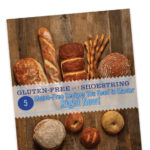I'm really and truly glad you're here. You took time out of your day to visit with me, and I'm grateful. If you have questions about Gluten Free on a Shoestring Bakes Bread, please see this comprehensive list of FAQs about Gluten Free Bread from the book.
For more general blog and book FAQs, you're in the right place.
Copyright protection notice/Use of photos
All of the content on this site—recipes, text, photos, videos—is protected by copyright. Please don’t republish anything verbatim.
If you’d like to write about one of my recipes without repeating the recipe, I’d love that. You’re welcome to use any one photo from each recipe on the site and republish it on your website as long as you provide a descriptive link back (describe the recipe you're linking to rather than just using “here” or “recipe here”).
- I can't find Expandex modified tapioca starch to use in your gluten free bread book, Bakes Bread. Can I just use regular tapioca starch in its place?
- I made [insert recipe name], and it didn't work! I'm freaking out, and it's up to you to fix it for me!
- I made your [baked good recipe], followed it to a “T” and it fell when it came out of the oven/didn't work at all! What did I do wrong?
- Would you post the nutrition/ fat / calories / points / diet / health information on [this] recipe?
- What all-purpose gluten-free flour do you recommend?
- My yeast bread didn’t rise! What happened?
- Why do only your most recent recipes include weight measurements?
- How were you able to write a cookbook? How can I do that?
- I’m new at this. Better Batter all-purpose gluten-free flour works as a cup-for-cup substitution. Can I just start converting my old recipes straight away?
- I have a blog, too, and I’d really like to exchange links. Are you interested in that?
- I don’t have [missing ingredient] in the house. Can I still make [a particular recipe]?
- Can your recipes be made dairy free? Free of all 8 common allergens?
- I'm British! How do I translate your recipes from American English — and what GF “plain flour” should I use?
- Why ask readers to buy your books when you have advertising to support your blog?
I can't find Expandex modified tapioca starch to use in your gluten free bread book, Bakes Bread. Can I just use regular tapioca starch in its place?
No, I'm afraid you cannot use regular tapioca starch in the recipes in Bakes Bread instead of modified tapioca starch. They do not behave the same at all. Please see this Resources Page on the blog for complete information on where to find Expandex. It includes information on how to use Ultratex 3, another brand of modified tapioca starch, in place of Expandex if you live outside the United States and cannot find Expandex. Please scroll down on this link to #6. All the information you need is there.
I made [insert recipe name], and it didn't work! I'm freaking out, and it's up to you to fix it for me!
It's not. If you're freaking out, I don't consider it my responsibility. This is my stock response when a reader hysterically blames a failed recipe on me, as all of the recipes in my book and on my blog are tested, and work if made as written: “So sorry it turned out that way for you. That must have been frustrating. I hope the next time you try the recipe it goes much better because it is a tested recipe and will work.” That is my only response. If you can relax a bit, we can move on to a more productive stage, and I will say, “If you would like to tell me in detail what you used for ingredients and how you prepared each step, I'm happy to review it to see where you differed from the original recipe as written. Let me know, and again, so sorry it didn't work for you.”
I made your [baked good recipe], followed it to a “T” and it fell when it came out of the oven/didn't work at all! What did I do wrong?
I test and retest (and retest again) all of the recipes on this blog and in my cookbooks before I publish them. It's a point of pride that I only publish recipes that actually work. When they are made as written, they will work. That being said, readers very often make changes to the recipe that they assume don't matter, but in a recipe, which is a formula, everything matters. Here is my checklist for a failed recipe attempt, to help you diagnose your problem:
- Did you use one of my recommended gluten free flour blends, or did you freestyle it? Flour blends matter, a lot.
- Did you measure by weight, instead of by volume? Measuring by volume is notoriously unreliable, even for the most experienced baker or cook. It is not only possible, but likely, to over- or under-measure flour by a full ounce (or 28 grams) when measuring by volume. It can turn a great recipe into a flop—fast.
- Did you use an oven thermometer? Most ovens are off by quite a lot (mine runs pretty hot). If you bake something in a too-hot oven, the outside cooks way too fast and will tend to burn before the inside is fully cooked. When it comes out of the oven, the baked good will fall as it cools as the inside cannot support itself.
- Did you make any substitutions? Unless I state otherwise in the recipe, I haven't tested it with any substitutions. If you make substitutions, you're going out on a limb. For example, you may have always had good luck substituting Earth Balance nondairy buttery sticks for butter in the past, but it won't work in every recipe.
Would you post the nutrition/fat/calories/points/diet/health information on [this] recipe?
Many of my recipes now list approximate nutrition information per serving. It is an automated estimate and should not be relied upon for medical or any other reasons.
I see that your recipes call for all-purpose gluten-free flour. What all-purpose gluten-free flour do you recommend?
Most often, I use Better Batter. It is very reasonably priced, and has the qualities I look for in a flour: fine grain, relative versatility, consistent quality, and good taste and smell. However, it is not the only gluten-free blend on the market. I have also tested three other all-purpose gluten-free flour blends (Cup4Cup, Jules, and Tom Sawyer). They each work in different ways and for different purposes. You can read everything you need to know about gluten-free flour blends on this page, and then decide for yourself which one you like best. I have also recently recommended a D.I.Y. All-Purpose Gluten-Free Flour blend, if you are inclined to blend your own. Another couple of notes about gluten-free flours: 1. Bean flour blends, like Bob's Red Mill all-purpose gluten-free flour, are NOT true all-purpose gluten-free flours. They do NOT behave the same as rice-based GF flour blends. If you use a bean blend in my recipes, they will NOT turn out as either of us intended or hoped. And the batter will smell bad. It's not the xanthan gum. It's the flour. 2. Pamela's Baking Mix is NOT an all-purpose gluten-free flour. It is a baking blend similar to Bisquick, as it contains many other ingredients, including baking soda and baking powder. If you use it as an all-purpose gluten-free flour, you will be creating an entirely new recipe, with entirely new proportions and, potentially, new ingredients. It is a good product, but use Pamela's recipes that call for it – not mine. It won't work, and you'll be mad. And maybe you won't know that that's why it all went wrong. Now you know.
My yeast bread didn’t rise! What happened?
Baking yeast breads is no big thing. You just need to get the hang of it. At the start of the chapter on Breads in my cookbook, there is a section entitled “Arise Fair Gluten-free Bread.” There you will find lots of tips and tricks. Some of that information is also here on the blog. The bottom line? You need to create a warm, moist environment for your gluten-free bread to rise. A 200 degree Fahrenheit oven may be what you used for proofing bread Before Gluten-Free, but it’s not going to produce consistent results for you now. It’s too dry, and most ovens do not reliably regulate temperatures 200 degrees F and below. It might work sometimes, but not all the time. And nothing is more expensive than wasted ingredients.
Why do only your most recent recipes include weight measurements?
I have been measuring my dry ingredients by weight for a long time now, but I know that many American cooks are troubled by the thought of baking by weight. I didn't want to be super directive about it, so I just wrote recipes with volume measurements and translated them to weight measurements for myself – and back again. Only recently did I realize — I could just include both volume and weight measurements. So I did. And I will going forward. Your choice which you follow, but if you are using an all-purpose gluten-free flour other than Better Batter, I strongly suggest you measure by weight or it's not a true equivalency.
How were you able to write a cookbook? How can I do that?
These days, to land a book deal, you need a platform. So you need to start a blog. I would suggest you choose to write about something you really really love, and that you work super hard at it. If it's right, it'll likely blossom. What you love tends to get bigger when you lavish attention on it. If you're not willing to work really hard, then you might want to reconsider your choice of topics. When you hit it right, it will be hard, but it won't feel as much like “work.”
I’m new at this. If my all-purpose gluten-free flour blend works as a cup-for-cup substitution. Can I just start converting my old recipes straight away?
Feel free to do that. I don't recommend it, particularly when you first begin baking gluten-free. If you enjoy going rogue, you should expect more success after working with at least a few of my recipes in various categories. You will learn what gluten-free bread dough should look like when it’s for a loaf of bread as distinct from a shaped bread; you will see what special care gluten-free cakes and cupcakes require. Soon enough, you’ll be ready to start converting your old recipes.
I have a blog, too, and I’d really like to exchange links. Are you interested in that? I do not do link exchanges. And you shouldn't either! Google doesn't like that.
I don’t have [missing ingredient] in the house. Can I still make [a particular recipe]?
You’re best off taking a little trip-ey-poo to the store. You can always sub in something, but if it doesn’t work (like really, really doesn’t work), you’ve wasted ingredients. Maybe try selecting another recipe for now, and make a note to go pick up some [eggs] next chance. And be sure to read the text of each recipe post for full information and additional resources on how you may be able to replace particular ingredients in a recipe.
Can your recipes be made dairy free? Free of all 8 common allergens?
It really depends. In most cases, dairy free will work just fine. In my book, unless I have indicated otherwise, all recipes can be made with nondairy substitutes. The rest, I’m sorry to say that I’m out of my depth. Post a comment asking the question. Maybe someone else knows. I can venture a guess, but take it with a grain of salt. Unless you can’t have salt. In which case, I’m not sure what to tell you.
I'm British! How do I translate your recipes from American English — and what GF “plain flour” should I use?
Although I'm not entirely fluent in British baking terms, this website does a fair amount of translating. For flour, I have heard good things about Dove's Gluten Free Plain White Flour, but I've never tried it myself, as it's not available on my continent.
Why ask readers to buy your books when you have advertising to support your blog?
I ask that blog readers buy my books to help support the blog, and the work I do on it, since advertising does not even come close to covering the cost of operating a blog (well, my blog at least). But both the blog and my cookbooks are a labor of love, as I believe that there is a tremendous amount of work to be done in the gluten-free community, and I am trying to do my part. But they are also my vocation. I pay hundreds of dollars in hosting fees every single month to keep the blog live – and to keep it loading fast. I also pay for website design and maintenance. Then there are all the baking materials for developing and testing recipes (most of which fail at least twice before they succeed, after which I have to repeat the recipe at least once to ensure that it is a truly successful recipe). Then there is the cost of my labor. Writing and publishing cookbooks is something that I enjoy at least as much as blogging. It is an opportunity for me really dig in and cover a subject fully, and speak to you in the long form that blogging just does not abide. So I ask that you support me, as I try my best to support you. I consider it a partnership.









